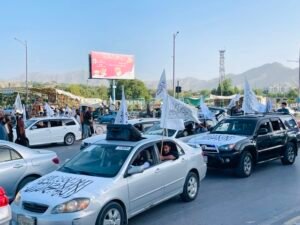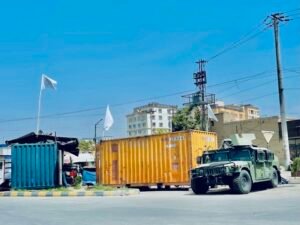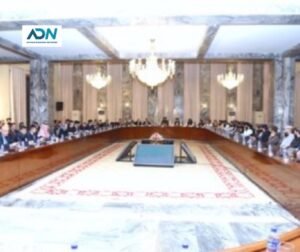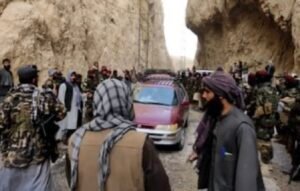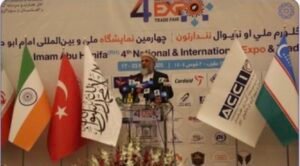Afghanistan’s Strategic Push to Reduce Economic Dependence on Pakistan
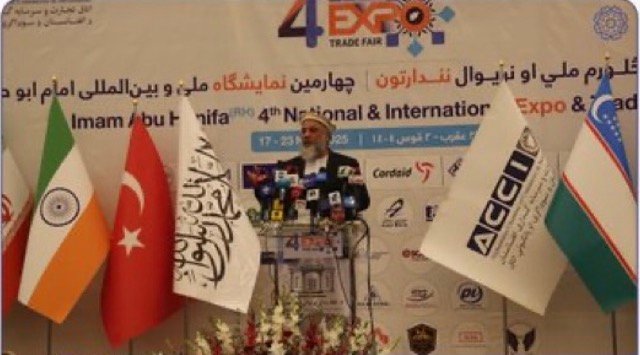
Nuruddin Azizi, the Taliban’s Minister of Industry and Commerce, inaugurated the Fourth National and International Imam Abu Hanifa Exhibition. Photo: From the X page of the Taliban Ministry of Industry and Commerce
By Nasir Khattak
Afghanistan is actively working to lessen its long-standing economic reliance on Pakistan, a shift driven by mounting political tensions, border conflicts, and the pressing need for economic diversification.[1] While Pakistan has historically been Afghanistan’s principal trade partner and transit route to global markets, recent escalations in hostilities and crossing points closures across Durand Line have underscored the vulnerabilities inherent in this dependence. Kabul’s efforts to pivot trade towards Central Asian neighbors represent both a strategic necessity and a complex challenge, reflecting deep-seated issues in regional stability and cooperation.
For decades, Pakistan has served as Afghanistan’s gateway to international trade through the ports of Karachi and Gwadar, supported by the strategic crossing points at Torkham and Chaman. Afghan merchants have relied heavily on these routes due to their relative proximity and cost-effectiveness. Pakistan’s export of essential goods such as fresh fruits, pharmaceuticals, textiles, and building materials to Afghanistan underscores this economic interdependence. Afghan trade through this corridor is estimated to be valued at $100 million to $200 million monthly. However, the situation deteriorated sharply following recent military confrontations between Taliban forces and Pakistani security personnel, culminating in a month-long crossing points closure that inflicted estimated losses of around $200 million on Afghan traders.[2]
In response, top Taliban officials have urged Afghan entrepreneurs to explore trade opportunities with the Central Asian republics, Uzbekistan, Kazakhstan, Turkmenistan, Kyrgyzstan, and Tajikistan.[3] This is a clear attempt to diversify Afghanistan’s trade routes and reduce susceptibility to Pakistani economic leverage, which Kabul accuses Islamabad of wielding as political pressure.
Kabul’s pursuit of alternatives is also driven by the enduring volatility at the Pakistan-Afghanistan crossing points. Repeated closures interrupt the flow of goods, leaving thousands of trucks stranded and disrupting supply chains vital to both economies. This insecurity has exposed the unreliability of Pakistan as a dependable regional partner. Despite Pakistan’s geographic advantage and infrastructural capacity, the political instability has rendered economic engagement fraught with uncertainty. Afghan traders and officials argue that uninterrupted transit routes are essential not only for bilateral trade but also for broader regional economic integration, yet these remain elusive under current conditions.
The unreliability of Pakistan as a trade partner is accentuated by its historical use of economic tools as instruments of political leverage. The crossing points shutdown across Durand Line, following armed clashes, serves as a poignant reminder of how political and military tensions translate into economic consequences for Afghanistan. This undermines trust and compels Kabul to seek alternatives not only for economic resilience but to reclaim agency over its trade policies. The necessity to mitigate risks inherent in overdependence on a single neighbor explains Afghanistan’s strategic recalibration toward Central Asia.
An encouraging regional development appears in the form of Uzbek President Shavkat Mirziyoyev’s proposal to form a “Community of Central Asia,” a regional bloc designed to enhance economic, security, and environmental cooperation among the Central Asian republics and neighboring Azerbaijan.[4] While Uzbekistan’s initiative aims at integration of a population exceeding 80 million, the bloc could also offer Afghanistan a platform for deeper involvement in regional economic networks, potentially supporting Kabul’s diversification goals.
However, despite the clear rationale for reducing dependence on Pakistan, economic realities continue to tether Afghanistan to its southern neighbor. Pakistan’s ports remain the fastest and most direct access points to maritime trade routes and South Asian markets, a logistical advantage not easily replicated. Afghan traders face a trade-off between the reliability and proximity of Pakistani routes and the higher costs and infrastructural deficiencies of northern alternatives. The ongoing friction thus places Afghanistan in a complex position of balancing political imperatives with economic pragmatism.
Afghanistan’s quest to cut its economic dependence on Pakistan emerges from a combination of geopolitical strain, Durand Line instability, and strategic recalibration aimed at fostering greater economic sovereignty. While the regime’s outreach to Central Asia signals an important shift in trade orientation, significant infrastructural, financial, and geopolitical challenges persist. Pakistan’s unreliability as a regional partner manifested in crossing points closures and political pressure tactics has forced Afghanistan to seek more diversified economic partnerships to safeguard its trade interests and regional integration ambitions.
The coming years will be critical in determining whether Afghanistan can successfully navigate this transition and build resilient trade networks beyond Pakistan’s shadow. This nuanced dynamic between Afghanistan and Pakistan highlights the broader challenges of regional interdependence where political disputes deeply affect economic connectivity and development. Afghanistan’s efforts, though fraught with obstacles, reflect a calculated move to assert greater control over its economic future within an often-turbulent South and Central Asian geopolitical landscape.
Nasir Khattak specializes in the China-Pakistan region, with a particular focus on the economic relations between the two countries.
Note: The contents of the article are of sole responsibility of the author. Afghan Diaspora Network will not be responsible for any inaccurate or incorrect statement in the articles.
[1] https://www.dawn.com/news/1955532
[2] https://thekabultribune.com/en/2032149
[3] https://www.rferl.org/a/afghanistan-pakistan-border-trade-central-asia-kazakhstan-uzbekistan-turkmenistan/33592451.html
[4] https://www.reuters.com/world/asia-pacific/uzbek-president-proposes-setting-up-bloc-central-asian-states-2025-11-16/

